Piecing It All Together with Brooklyn Tweed
After spending time talking to, and visiting, with Brookly Tweed’s staff, it’s clear to see that the knitting, design and manufacturing company is more than just a business. It’s a community, spurred by founder Jared Flood’s passion for the therapeutic process of creating timeless pieces with one’s hands. After a recent visit to the company’s new office space in SE Portland, we chatted with co-owner Luigi Boccia about how Brooklyn Tweed has evolved to meet the needs of its community, domestic textile production in the USA, and of course, how perfectly well knitting and coffee pair together.

Can you tell us more about how Brooklyn Tweed came to be, and how it transitioned from a blog for knitters to the business as it is today?
In 2005, Jared Flood, our Founder and Creative Director was 23-years-old and decided to move from his native Tacoma, WA to Brooklyn, NY. A recent undergraduate of the University of Puget Sound, Jared was looking into enrolling in an MFA at the New York Academy of Arts, but decided to take two gap years before applying for the program. The plan was to find a job and soak in everything a city like New York has to offer to a young aspiring visual artist. Between job and apartment hunting, Jared got bit by the knitting bug as a way to relax and recharge at the end of the day. His interest in the craft soon fired his endless curiosity, and his love and appreciation for colors and fibers. Jared grew up in a household where there is great appreciation for knitting and natural fibers. While reading knitting books and learning new techniques was something that Jared could do on his own, what was missing was the joy to share with others, to learn from others and to feel part of a community. That's when he decided to start a blog, and to call it Brooklyn Tweed. The Brooklyn part is due to where he was living at the time, and the Tweed part, is a result of his innate appreciation for tweedy fibers, particularly known for the depth and richness of their colors (an appealing aspect to someone with a painterly predisposition towards color).

Jared's own writing and photography soon turned the blog into a popular stop among the internet savvy knitters of the time. When Jared decided to dip his toes into the knitwear design process, the patterns he created were published by reputable companies at the time and were very well received by the community at large, thus changing the public perception of Jared from being a blogger to being a designer.
In 2009, after a few years of freelance work, Jared started exploring the possibility of developing the yarn line of his dreams. He learned pretty quickly that it was extremely hard to source and manufacture a high-quality hand knitting yarn in the United States. The U.S. textile industry had just taken a big hit during the financial crisis of 2008, and most yarn companies were preferring "out of the box" products that were manufactured overseas and came with a lower and more competitive price tag. Since the very beginning, Jared had envisioned not only a yarn line that would be fully traceable, sourced and manufactured in the States, but also a yarn line that was made with breed-specific fiber. After thorough research, he was able to find a ranch in Johnson County (WY) that would provide Columbia-Targhee fiber, a scouring facility in Texas, a dye house in Pennsylvania, and a mill in New Hampshire. This breed-specific, entirely domestic yarn line was released to the public in October 2010 and was called Shelter. The launch of Shelter signifies also the passage from a blog to a company.
To this day, Shelter is one of the most iconic yarns in the knitting world, and coincidentally, the product that more quintessentially summarizes what we are about as a company: timeless materials for hand knitters. Since Shelter, we have released five more core yarn lines, two single batch ranch-specific yarns, approximately 600 patterns, and have built three entirely independent and self-sufficient domestic supply chains.

How does Brooklyn Tweed connect with its community of knitters, and offer a space for both the expert and novice knitter?
We like to interact with our community of knitters in many different ways. The means that we utilize to reach out to our customers are not very different from what most companies do these days; social media, a newsletter, direct emails, and blog posts. The efforts behind our outreach are specific to our industry. Whether we launch a new yarn line, a new color, a new pattern or collection, there is always the intent to inform and educate our customers. Information is service, and there is so much to share -- whether it's knowledge about the sourcing and manufacturing process, or encouraging our knitters to try new knitting techniques, we strive to push boundaries and elevate the craft. This serves well both the expert and the novice knitter, because there is always more to learn, and we love that our knitters have the same attitude. The best compliment we receive is when we hear that customers feel they are better knitters after they have knitted with one of our patterns. That forms a strong connection, as the benefits transcend the quality of the product, and enters the territory of personal empowerment.

Why is it important to support domestic textile manufacturing? Is it difficult to design, dye, source, and spin all your yarn in the United States?
It's very difficult, but not impossible. It requires more time, more risk, more up-front capital, and a more hands-on approach. In 2007, when the mortgage crisis brought the economy down here in the U.S. and abroad, one of the sectors that suffered the most was the domestic textile industry, or whatever had been left of it after decades of severe outsourcing. If before 2007 there was still a resemblance of what once used to be a thriving economic force, after 2007 the domestic manufacturers still running in the textile industry (in particular in the yarn industry), were few and far between. It was almost as if the residue of the infrastructure that had been in place for decades finally collapsed, leaving anyone interested in manufacturing in the U.S. with the singular task of connecting dots on the map in order to scramble supply chains.The manufacturers that remained in business were mostly small to medium, family-owned and run businesses -- in other words, companies that were [just as] concerned about the bottom line as much as they were protective of carrying the family legacy from one generation to another. The manufacturers we work with today are also the repositories of the knowledge and skills required to manufacture a quality product. However, oftentimes their equipment is not the most technologically advanced, or the labor force is not as experienced as manufacturers overseas, so we like to have a hands-on approach when it comes to designing, dyeing, sourcing or spinning the yarn, because we want to make sure that we offer our partners all the support they need to make not just a good yarn, but some of the best yarns one can produce in the U.S.. In a nutshell, it’s not difficult or unusual for us to shoot for the stars in our processes, but we know we also need to be as supportive as we can of our partners throughout the journey that helps us reach the stars.

We’re so interested in the yarn supply chain you’re part of! Can you tell us more about who contributes to the process of making your yarn and give us an idea of the step by step process?
We have successfully built three domestic supply chains, and are in the process of building a fourth. This is one of the most rewarding aspects of our company mission. Our Founder and Creative Director, Jared Flood, is the one who conceives and designs a new yarn. After the initial conversation, the task is passed on to our Yarn Production Director, Stephanie Engle, who starts looking for the right fiber source/breed, while assessing who, among our current or prospective partners, could do the best job at scouring, dyeing or spinning the yarn. The steps are very simple; once the sheep are shorn during shearing season, the fiber needs to be scoured (cleaned or washed). After that, the yarn is dyed and spun, twisted, labeled, bagged and shipped to us in Portland.
Who is the knitting community Brooklyn Tweed supports? Where are your knitters from? Who are they?
One of the most energizing parts of our community is that it encompasses a wide range of ages, professions and geographic locations. We ship our yarns to customers all over the world, and social media allows us to see many of the beautiful creations that our customers make with our products, whether they be our own house designs, patterns by other designers, or completely original creations by the knitters. Our primary customer base is in the U.S., though we ship orders (both wholesale and direct-to-customer) in many countries around the world.

What types of patterns and yarns does your community love? Do you have any specific bestsellers?
As a design company, we have focused on quality design that is stylish and modern, but with a timeless appeal. We love classic knitwear design — the history and nostalgia of it — and are inspired by ways we can bring these elements into the modern-day wardrobe. Handknitting with high-quality natural fibers means creating heirloom quality garments that can be worn for a lifetime, and even passed down from one generation to the next. This concept guides our design sensibility. While we want knitters to find things that feel current and wearable today, we also want to imbue our designs with a timeless quality, thinking they could be worn 15 or 20 years ago, or 15 to 20 years from now, and so on. Of course, these decisions are somewhat subjective, but this is one of the things we think about when we are putting together a knitwear collection.
Equity and inclusivity are important parts of your business and mission. Can you share more about why this is so important in the knitting world?
Equity and inclusion have always been important to us as people, and we are grateful that these topics are receiving wider discussion in our, and many other, industries online in the past year. It is important for us to continue learning about our own blind spots of privilege, and to continue asking ourselves what we can do to make marginalized groups feel welcome and valued in our community. This year we have published our company’s Equity and Inclusion pledge on our web site to share what efforts we are making as a company towards continued learning and action in this regard. This is a “living” document that we have written to increase our own accountability in our community, as well as to guide us in all manner of decisions we make as a business and as a team of makers.

What kinds of events does Brooklyn Tweed host? What do you have in store for fall and winter?
We like to organize events for makers, writers, thinkers, local entrepreneurs, and educational or social activists. We love learning, and we love meeting people that can enrich our perspectives and our level of understanding of our community and society at large. We had to take a little break with our programming, as this year we launched our new website and moved into a new building, and these two events took up pretty much all of our extra bandwidth. However, we can’t wait to resume with our Knitting Culture series, which despite the name, is not just about knitting, but more in general about all the things that knitters might be interested in; crafts, animal care, environmental and social justice, literature, movies etc.
What are your favorite fall/winter yarn shades and patterns?
We are passionate about rich, painterly color and tend to favor jewel tones, and the colors of nature in Autumn. Most of our palettes feature multiple, saturated rich reds, mustards, and navy(s). We are also lovers of grey and toned neutrals, which feature heavily across all of our yarn lines! As far as patterns go, give us an oversized, cabled cardigan any season and we will be happy!

We love your new office! What consideration went into choosing the new space, and how does it feel to collaborate as a team in this space? Do you have any daily rituals you do together?
We are excited about our new space. We used to be on NE 12th and Davis, and now we are on NE 7th and Davis, so literally five blocks down as the crow flies. The first consideration was the proximity to our older place. Most of our team members either walk or ride their bikes to work, and we know what a difference that makes to people in terms of quality of life. We also love the Central Eastside of Portland, and think that it’s the perfect blend of residential and commercial. We hope this area never loses that hybrid nature, because it’s inspiring to work where other people live, and to live where other people work. Plus, with Martin Luther King Boulevard and Burnside Street so close now, it’s so nice to be able to go out for a walk or to grab a quick bite.


Of course we have to ask you about the connection between knitting and coffee! What is your favorite type of coffee to enjoy when you’re knitting, or favorite coffee/knitting ritual?
It’s fair to say that whether it’s tea or coffee, knitters consider sipping on a good cup as integral to knitting itself. It’s part of the fantasy; sitting on a comfortable chair, possibly in front of a fireplace or wood stove, a steaming cup of tea or coffee on a side table and an audiobook, a podcast, or some good music in the background. Now, I bet you are not surprised why knitting can be one of the best forms of therapy or self care :). Being Italian, I love all forms of coffee. My parents started letting me have coffee when I was 10-years-old. A cup of espresso at the end of lunch, like a digestive. Over the years, I have come to appreciate coffee in all of its variations. After 14-years in the States, I have grown much appreciation for drip coffee. I like the warmth of a large cup in your hands and, unlike Espresso which means fast, I enjoy taking a half hour or longer to finish my coffee.

It’s clear from visiting you, and getting to know the Brooklyn Tweed team, that enjoyment of knitting and the enjoyment of coffee are quite the symbiotic pair. Why do you think this is?
It’s a combination of things. Most of our team members are knitters and most times take a 10 minute knitting break from the screen. That’s a perfect moment to refill three cups. I also think that Portland has such a great coffee culture that it’s fun to try different roasts and different machines. We are truly blessed to have a Ratio coffee maker in our kitchen. It’s a combo of quality and good design, which is how we would describe Brooklyn Tweed. In addition, it makes great coffee, and that’s the reason why we automatically brew two pots in the morning, so no one is left without their coffee. We care about harmony in our office environment after all!
Instagram: brooklyntweed
Web: Brooklyn Tweed
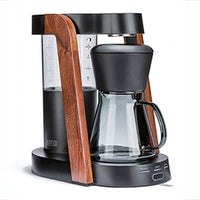 Ratio Eight S2
Ratio Eight S2
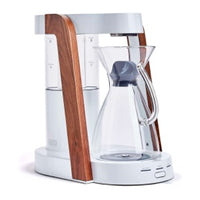 Ratio Eight Original
Ratio Eight Original
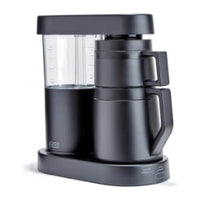 Ratio Six
Ratio Six
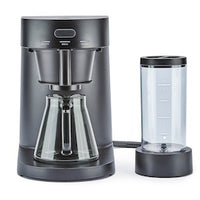 Ratio Four
Ratio Four
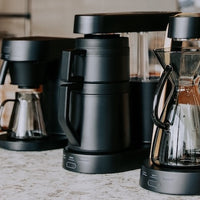 Compare Machines
Compare Machines






